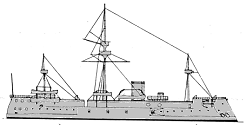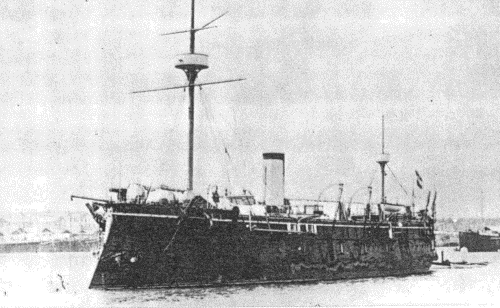
NAVYPEDIA
 Support the project with paypal
Support the project with paypal
Photo

Kaiser Max 1876
Ships
| Name | No | Yard No | Builder | Laid down | Launched | Comp | Fate |
|---|---|---|---|---|---|---|---|
| Don Juan d'Austria | 117 | STT, San Rocco | 14.2.1874 | 25.10.1875 | 26.6.1876 | stricken 6.1904 | |
| Kaiser Max | 118 | STT, San Rocco | 14.2.1874 | 28.12.1875 | 26.10.1876 | stricken 12.1904 | |
| Prinz Eugen | Marinearsenal Pola | 10/1874 | 7.9.1877 | 11/1878 | stricken 12.1904 |
Technical data
| Displacement normal, t | 3548 |
|---|---|
| Displacement full, t | |
| Length, m | 75.9 oa 73.2 wl |
| Breadth, m | 15.3 |
| Draught, m | 6.15 |
| No of shafts | 1 |
| Machinery | 1 2-cyl HRCR, 4 rectangular boilers |
| Power, h. p. | 2755 |
| Max speed, kts | 13.3 |
| Fuel, t | coal 380 |
| Endurance, nm(kts) | 2000(10) |
| Armour, mm | wrought iron; belt: 205, bulkheads: 115, casemate: 125 |
| Armament | 8 x 1 - 209/18 G. L/20 C.68, 4 x 1 - 87/22 G. L/24 M.75, 2 x 1 - 66/16 G. L/18 |
| Complement | 400 |
Standard scale images

Kaiser Max 1880
Graphics
Project history
For political reasons new ships were at times not approved in the budget, but the rebuilding of existing ships was generally passed without opposition. Therefore the three obsolete armoured frigates of the Kaiser Max class were 'officially rebuilt'. In fact the rotten wooden hulls were scrapped, only the machinery without boilers, parts of the armour and serviceable parts of the equipment being used on completely new iron casemate ships with the same names. This often leads to confusion between old and 'rebuilt' ships. However, one conversion was three times as expensive as the building of a new warship, so the polity was ill advised. The original sail area of 1633.15m2 was reduced to 1158.60m2 in 1880.
Ship protection
The belt protected all ship length extending from 1.2m under wl to 1.7m above. Its thickness was 203mm amidships and 120-102mm at ship ends, the belt was backed by 254mm teak. Casemate was connected with upper edge of the belt and consisted from 152mm(to under edges of gun ports)-120mm(above) sides, transverse bulkheads were 120mm; casemate armour was backed by 318mm teak layer. Casemate was closed by 19mm deck.
Modernizations
1880: + 4 - 350 TT (1 bow, 2 beam, 1 stern)
1890s: + 6 x 1 - 47/30 SFK L/33 H, 3 x 5 - 47/22 SFK L/25 H, 2 x 5 - 25/41 Nordenfeldt
Naval service
Kaiser Max was stricken on 30.12.1904, and from 1909 she was an accommodation ship at Cattaro Bay; in 1920 she was ceded to Yugoslavia and renamed Tivat. Prinz Eugen was stricken on 30.12.1904; she was converted to a repair ship and renamed Vulkan; later her name was needed for one of the new Tegetthoff class dreadnoughts. In 1919 she was confiscated by Italy and towed away. In 1920 she was allocated to Yugoslavia but was never handed over to her new owners. Don Juan d'Austria (the different spelling serves to distinguish her from her predecessor, Juan de Austria) was stricken on 29.6.1904, and in 1905 she became an accommodation ship for torpedo boat staff. She sank in 1919 in circumstances which are not clear.
 HOME
HOME FIGHTING SHIPS OF THE WORLD
FIGHTING SHIPS OF THE WORLD AUSTRIA-HUNGARY
AUSTRIA-HUNGARY CAPITAL SHIPS
CAPITAL SHIPS KAISER MAX centre battery ships (1876-1878)
KAISER MAX centre battery ships (1876-1878)

